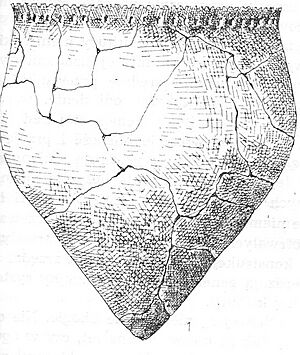Narva culture facts for kids
| Geographical range | Europe |
|---|---|
| Period | Mesolithic |
| Dates | c. 5300 — c. 1750 BC |
| Type site | Narva River |
| Preceded by | Kunda culture |
| Followed by | Pit–Comb Ware culture, Corded Ware culture, Brushed Pottery culture |
| The Mesolithic |
|---|
| ↑ Upper Paleolithic |
|
| ↓ Neolithic |
The Narva culture was an ancient group of people who lived in parts of Europe a very long time ago. They lived in areas that are now Estonia, Latvia, Lithuania, and parts of Poland, Belarus, and Russia.
This culture existed during the Neolithic period, also known as the New Stone Age. It lasted for a long time, from about 5300 BC to 1750 BC. That's over 3,500 years! The Narva people were mostly hunter-gatherers, meaning they hunted animals, fished, and collected plants for food. The culture is named after the Narva River in Estonia, where many of their ancient sites were found.
Contents
Tools and Daily Life of the Narva People
The Narva people were very clever with the materials they had. They didn't have much flint, which was a very important stone for making sharp tools back then. So, they had to be careful with their flint and often reused it. This means they had to trade with other groups to get more flint. Scientists have found pink flint from far away, showing they traded over long distances.
Instead of flint, they used lots of local materials. They made many tools from bone, animal horns, and a type of rock called schist. These bone tools are a big clue for archaeologists. They show that the Narva culture continued many traditions from an older group called the Kunda culture.
- Special Tools: One cool discovery is a special ceremonial cane. It was carved from an animal horn to look like the head of a female elk. This was found in a place called Šventoji.
- Amber Trade: The Narva people also used and traded amber, which is fossilized tree resin. Hundreds of amber items have been found at sites like Juodkrantė.
The Narva people were mainly fishers, hunters, and gatherers. They slowly started to keep some animals for food later in their history. They didn't move around a lot like some other ancient groups. They lived in the same places for a long time. We know this because archaeologists found lots of pottery, piles of ancient trash called middens, and structures they built in lakes and rivers to help them fish.
Narva Pottery
The pottery made by the Narva people has some unique features. They often mixed their clay with other natural materials, like crushed snail shells. This made their pottery special.
- Pottery Style: Their pots were made from wide strips of clay, about 6 to 9 centimeters wide.
- Decorations: They usually had very simple decorations, mostly around the rim (the top edge) of the pot.
- Shape: The pots were often wide and large, with the height and width being about the same. Most had pointed or rounded bottoms. Only the very latest pots had flat bottoms.
Over time, the Narva pottery style changed. It was influenced by other cultures, like the Corded Ware culture, and eventually, the Narva pottery style faded away.
Discovering the Narva Culture
For a long time, archaeologists thought that the first people in this region were from a group called the Finno-Ugric. They believed these people were later pushed north by the Corded Ware culture.
But in 1931, a Latvian archaeologist named Eduards Šturms noticed something different. He found artifacts near Zebrus Lake in Latvia that didn't match what they expected. He thought they might belong to a completely new culture.
Later, in the early 1950s, more ancient settlements were dug up along the Narva River. Two archaeologists, Lembit Jaanits and Nina Gurina, studied these findings. They put them together with other similar artifacts from the eastern Baltic region and officially described what we now call the Narva culture.
At first, people thought the Narva culture ended when the Corded Ware culture appeared. However, newer research shows that the Narva culture actually lasted much longer, right up until the beginning of the Bronze Age.
Because the Narva culture lasted for thousands of years and covered a huge area, archaeologists are still trying to understand all its different parts. They are looking at how the culture might have changed in different regions or at different times. For example, in Lithuania, they see two main areas: a southern one influenced by the Neman culture and a western one with big settlements like those found in Šventoji.
Scientists are also still debating what ethnic group the Narva people belonged to. Were they Finno-Ugrians or another group of Europids? It's also a puzzle how the Narva culture fits with the arrival of the Indo-Europeans (who brought cultures like the Corded Ware and Globular Amphora culture) and how the Baltic tribes formed. There's still a lot to learn!
See also
- Pitted Ware culture
- Rzucewo culture
- Dnieper-Donets culture


